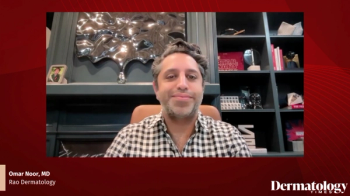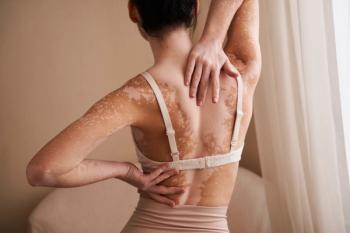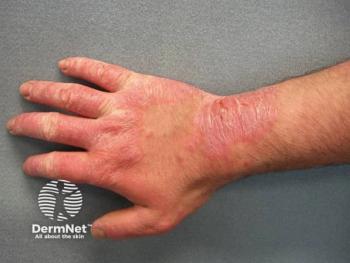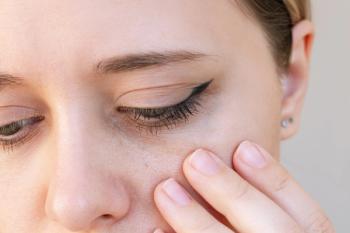
Oxymetazoline 1% Cream Reduces Erythema in Patients with Rosacea
Key Takeaways
- Oxymetazoline 1% cream significantly reduced rosacea-associated erythema in patients with darker skin tones after four weeks of use.
- The study showed significant decreases in CEA and PSA scores, indicating improved rosacea symptoms and patient satisfaction.
The product was safe and effective after 4 weeks of topical use, specifically on patients with darker skin types.
Oxymetazoline 1% cream was tested for mild to moderate rosacea-associated erythema on the face.1 After 4 weeks, the topical effectively decreased redness, stratum corneum hydration, telangiectasia, and vessel diameter in patients with darker skin tones. Oxymetazoline hydrochloride is an α1A adrenoceptor agonist that was approved by the US Food and Drug Administration in 2017.
The phase 2 before-after study took place at the Center for Research and Training in Skin Diseases and Leprosy (CRTSDL) at the Tehran University of Medical Sciences in Tehran, Iran from May to October 2020. The trial included 15 patients from the Middle East, who generally have a darker skin type compared to patients in Europe and North America. The 12 females and 3 males were between the ages of 18 and 50.
Participants applied the cream twice daily for 4 weeks after washing their face with a mild cleanser. A thin layer was applied every night on any areas with erythema like the forehead, cheek, or chin. Moisturizer and sunscreen use was also recommended.
Investigators recorded biometric parameters like transepidermal water loss, sebum, stratum corneum hydration, temperature, erythema, melanin, and pH. These were measured using the Tewameter TM 300, Sebumeter SM 815, Corneometer CM 825, Skin-Thermometer ST 500, Mexameter MX 18, and Skin-pH-Meter PH 905 probes of CutometerMPA 580. The thickness and echo density of the epidermal and dermal layers, as well as the capillaroscopic pattern of lesionswere also evaluated.
The Clinician’s Erythema Assessment (CEA) and Patient’s Self-Assessment (PSA) 5-point scales were used as well. Each participant began with a CEA score between 3 and 4.
“Although CEA and PSA are not objective assessments, a significant reduction of them is of great importance, because it means improvement of rosacea symptoms from the physicians' and patients' perspectives, and their satisfaction with the treatment,” the authors wrote.
CEA and PSA scores decreased significantly after 2 and 4 weeks (p-value: 0.001). At baseline, the average CEA was 3.46. This decreased to 2.60 after 2 weeks and 2.20 after 4 weeks. The average PSA was 3.26 at baseline, which was then reduced to 2.33 at the 2-week visit and 2.06 at the 4-week visit.
Erythema was also reduced (p-value: 0.001), according to the Visioface digital photography imaging system. More specifically, the mean erythema difference between the lesions and healthy skin (6.07) dropped after 2 weeks (5.12) and 4 weeks (4.50). The difference between baseline and the week 4 mark was statistically significant. Erythema is the most consistent feature of rosacea, yet it is the most difficult to treat.2
Baseline average lightness (−4.45) increased after 2 weeks (−4.36) and 4 weeks (−3.67). These changes were statistically significant. Additionally, stratum corneum hydration decreased significantly after 2 weeks (p-value: 0.02) but not after 4 weeks. Telangiectasia and vessel diameter decreased while the reddish background became paler, according to the FotoFinderMedicam 1000 video dermatoscope.
No other biophysical changes were noted, demonstrating that the product did not damage the skin barrier. Additionally, no adverse effects like drying, itching, redness, stinging, or hyperpigmentation were reported. Even with the small sample size, these skin biometric assessments confirm that the oxymetazoline cream 1% improves rosacea-associated erythema. According to the authors, “it appears to be safe and effective for its approved indication, with less rebound effect (1%) compared to the alternative available treatments.”
References
1. Sajdeh F, Samadi A, Naeimifar A, et al. Efficacy and Safety of Oxymetazoline 1% Cream for the Treatment of Mild to Moderate Facial Rosacea. J Cosmet Dermatol. 2025;24(4):e16782. doi:10.1111/jocd.16782
2. Del Rosso JQ, Tanghetti E. Topical Oxymetazoline Hydrochloride Cream 1% for the Treatment of Persistent Facial Erythema of Rosacea in Adults: A Comprehensive Review of Current Evidence. J Clin Aesthet Dermatol. 2021;14(3):32-37.
Newsletter
Like what you’re reading? Subscribe to Dermatology Times for weekly updates on therapies, innovations, and real-world practice tips.



















